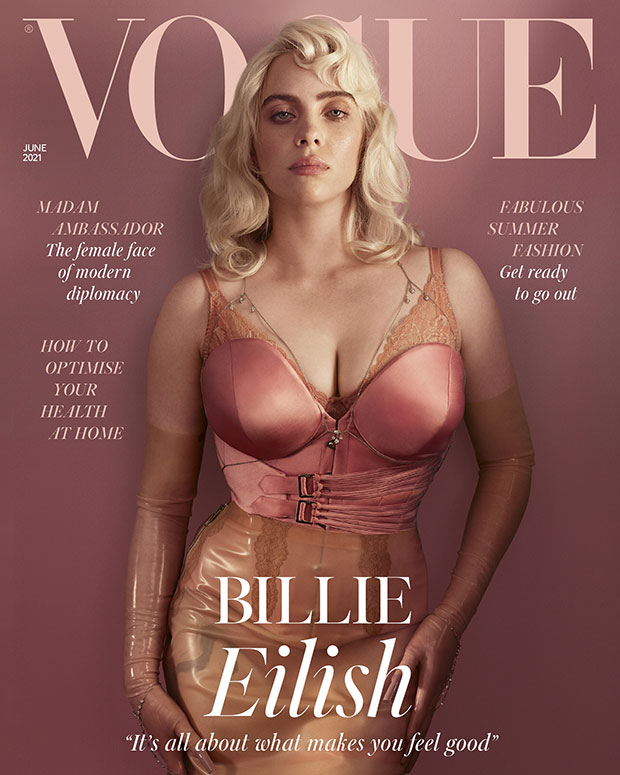“I’m not letting myself be owned anymore:” Billie Eilish’s Vogue Cover
May 29, 2021
“I’m not letting myself be owned anymore:” Billie Eilish’s Vogue Cover
By Emma Oscilowski
“I could easily just be like, you know what, you’re going to pick out my clothes, someone else will come up with my video treatments, someone else will direct them and I won’t have anything to do with them…but I’m not that kind of person and I’m not that kind of artist.”
-Billie Eilish
* * *
Consistently challenging society’s unattainable beauty standards, Billie Eilish has become popular for her music and her unconventional style. Not only has she advocated for body positivity, but she has also expressed her disappointment about how emotional and physical abuse has become commonplace. Through her song lyrics, her social media, and her marketing opportunities, Eilish has relentlessly encouraged acceptance within the universal pockets of society. Eilish’s recent photoshoot with Vogue and interview with Laura Snapes speak volumes about her devotion to advocacy.
Billie’s struggles with body image and beauty standards are deeply rooted in her past. Growing up as a dancer in an environment where success is based on body type, she developed body dysmorphia at the age of 12. At first, she combatted the low self-esteem that resulted by following a rigorous diet…then she attempted to lose weight by taking pills. All of this, again, at the age of 12. These feelings must have been beyond demeaning. Due to the emotional burdens and societal expectations that weighed down upon her, like many young people, Eilish resorted to self-harm: “I felt like I deserved to be in pain,” she said.
After gaining monstrous fame very quickly, it was not long before Eilish adopted the style most people associate with her name today: boxy shirts, basketball shorts, along with her renowned bright green and black hair. Where did her style come from? In a campaign for Calvin Kelin, Eilish told the media that she dressed in baggy clothes to avoid judgment. She decided to dress this way out of fear. Fear of being unnecessarily judged. Fear of being sexualized: something the media does with cruel, ruthless excellence simply to gain a following that eagerly buys their lies and attempts to destroy a 19-year-old’s self-esteem. When talking about different ways the public may perceive her body, she concludes “No one can say any of that because they don’t know.” Negatively impacting countless girls and boys, society’s constructs on body image have made Eilish less confident in her skin throughout her past.
Yet, as you may have seen while it trended across the internet for days, Eilish released a new cover for British Vogue where she chose not to wear oversized clothing. Instead, Eilish adorns a light pink corset and high latex gloves. In doing so, she has challenged herself by wearing the clothes she feels confident in rather than the clothes she feels comfortable in. The decision to dye her hair platinum blonde and to experiment with her style was entirely her own. Vogue magazine’s editor-in-chief, Edward Enninful, reflects on their conversation, “What if she wanted to play with corsetry and revel in the aesthetic of the mid-20th century pin-ups she’s always loved? It was time, she said, for something new.” At first, Eilish was unsure how the public would react…but she took a second to reassure herself: “Let’s turn it around and be empowered in that. Showing your body and showing your skin — or not — should not take any respect away from you.”
Beneath her picture on the front cover reads “It’s all about what makes you feel good,” – expressing that people have the right to wear whatever they please. As a respected celebrity, Eilish has used her fanbase to advocate for body positivity, actively helping others avoid the mental agony she endured while facing body dysmorphia. Eilish is a role model for all young people who have experienced shallow judgment and who have suffered from mental illness, whether or not they share the same reasons for their mental health issues.
Furthermore, the recent photoshoot and interview for British Vogue signify Billie’s support for people who have been victimized. In her interview, Eilish spoke to her past experiences with abuse and her disappointment in society, revealing the message of her new song called ‘Your Power.’ “You can always be taken advantage of. That’s a big problem in the world of domestic abuse or statutory rape — girls that were very confident and strong-willed finding themselves in situations where they’re like, ‘Oh my god, I’m the victim here?'” This previous experience made Eilish feel powerless, a feeling displayed through her baggy clothes, as she decided to hide her body. When she said “I’m not letting myself be owned anymore,” she pledged to be in charge of her actions. She has reclaimed confidence in her willingness to create her own happiness, despite a past riddled with pain.
In taking charge of her career and embracing new opportunities that excite her, Billie Eilish has taught her supporters to do the same. Her photo shoot reminds everyone that beauty standards are narrow-minded and baseless; they do not foster confidence, rather they beat people down. Eilish has made all of her choices on her own, contending her values to her fans. Her choices will not be defined by the opinions of others. Neither should anyone else’s.
